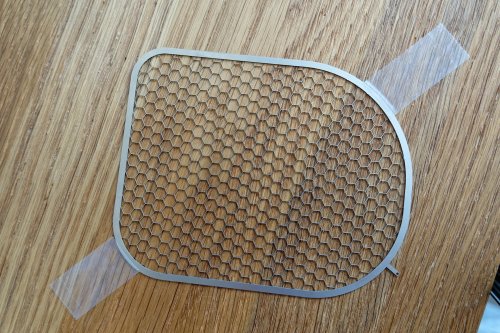Practical realities.
Having now had various components manufactured, unexpected practical realities have begun to intrude and I've spent recent weeks altering my design to control costs and make production a practical reality. The driving difficulty has been bonding components together with conductive epoxy without beads of the adhesive intruding into the space in front of the stator - it is not a happy moment when you discover that your very expensive parts are scrap

and you are to blame!

I am close to eliminating a stator cut from woven wire mesh from the list of possibilities because of these bonding difficulties [sad because they are about 30p each], but I have a new foil design on order which is intended to be welded to the support structures. Delivery is a few days away. The foil stock from which this is chemically milled is 0.1mm thick.

The closed areas dotted about the grid of rectangular holes in the image are welding pads that correspond to the three-limb junctions between the hexagons in this support component which is 1mm thick...

The parts fit together so....

A wire mesh stator would be acoustically superior because the wires can be as thin as 35-50 microns making the component acoustically transparent into the 100s of kilohertz region, but I just cannot glue them cleanly, and they cannot be welded - when the wire melts at the junction, surface tension pulls it away from the bond. This is why the boys with lots of development funds available are turning to diffusion bonding which doesn't melt the metal at all. Unlike woven wire, a foil component welds perfectly to the underlying support and laser welding does not distort it, so flat is easy. The bond will be finished by wicking low viscosity cyanoacrylate adhesive into the area between foil and support to eliminate any possibility of buzzing. The welds, of course, make foil and support electrically continuous.
I am certainly not going to show you ruined stator attempts, it's embarrassing, but this image may be of interest...

It's a laser cut, 0.25mm thick part that my number one adviser company made, just for the hell of it - totally impractical, the holes are too big and the separating lands way too narrow [0.1mm]. It took 2 hours to make, so £250 if I wanted to buy it, while reducing the holes from 5mm to 1.5mm and increasing the lands to 0.25mm wide would yield a part that could be made but would cost £1000. The chemically milled foils are £32 each in batches of 4 [one pair of headphones] and about £19 each in batches of 50.
I've also been working on enclosing the driver units - not too difficult - and attaching them to a practical headband which is driving me crazy. I can make test sets simply by enclosing each earpiece in a cloth bag with a strap running over my head, but it's hardly a practical set of cans!
Here is my design slate for the headband with the main components in the right places...

The difficulty is that the earpieces are intended to swivel inwards and outwards on the two pivot pins shown to allow the listener to choose between bass weight and stereo image quality and the earpieces are very big, so suspending them on the head without the headband intruding into the acoustic zone is a nightmare.
Ed Form






















 and you are to blame!
and you are to blame! 







